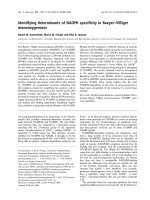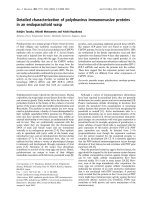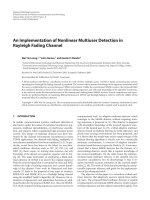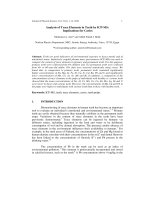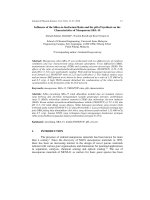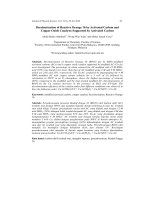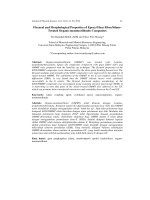Báo cáo vật lý: "Mixing Behavior of Binary Polymer Particles in Bubbling Fluidized Bed" doc
Bạn đang xem bản rút gọn của tài liệu. Xem và tải ngay bản đầy đủ của tài liệu tại đây (420.58 KB, 17 trang )
Journal of Physical Science, Vol. 19(1), 13–29, 2008 13
Mixing Behavior of Binary Polymer Particles
in Bubbling Fluidized Bed
S.M. Tasirin, S.K. Kamarudin
*
and A.M.A. Hweage
Department of Chemical and Process Engineering, Universiti Kebangsaan Malaysia,
43600 UKM Bangi, Selangor, Malaysia
*Corresponding author:
Abstract: Fluidized bed mixer offers the most efficient and economical process
compared to other mixers. However, less effort has been devoted to understand the local
behavior of the solids in fluidized bed, partly due to the lack of reliable experimental
methods. Thus, the objective of this paper was to view the local mixing behavior and
property of a free flow polymer binary mixture in bubbling fluidized bed. In this work, an
experimental study of mixing process of free flowing polymers binary mixtures at
different densities and colors in bubbling fluidized were investigated. The mixing
properties were studied by analyzing the variation of the proportions of the marked
particles with time and position in the bed. The variation of mixture composition based
on the samples incorporated into Lacey mixing index that describes the degree of mixing
of the particle at particular time. This method enables the assessment of the overall
mixing behavior in terms of the rate of mixing (through estimation of the time required
for the mixing index to increase from zero to a certain value) and with the degree of
mixing at the mixing equilibrium stage. Finally, the parameters were optimized. Results
showed that gas velocity and bed depth were important parameters influencing the solids
mixing in the bubbling fluidized bed. From the results, complete mixing of binary
polymer particles was attained at a bed depth of 17 cm and gas velocity of 1.38 U
mf
in the
fluidized bed.
Keywords: polymer particles, mixing, fluidized bed
1. INTRODUCTION
Fluidized bed mixer offers the natural mobility afforded particles in the
fluidized bed. The mixing is largely convective with the circulation patterns set
up by the bubble motion within the bed.
1
An important feature of the fluidized
bed mixer is the ability of conducting several procedures like mixing, reaction,
coating, drying etc., is single vessel. On the other hand, based on the energy
consumption analysis, it has been found that a fluidized bed mixer offers the
most efficient and economical process compared to other mixers. However, less
effort has been devoted to understand the local behavior of the solids in the
fluidized bed, partly due to lack of reliable experimental methods.
2–5
Quantification of solids flow pattern and solids mixing is very essential for
proper design and scale-up of fluidized beds.
6
The basic mechanism of solid
Mixing Behavior of Polymer Particles 14
mixing in bubbling fluidized bed is well-understood but it is still not possible to
predict the effect of operating parameters on the degree of mixing in a fluidized
bed.
7
Thus, the objectives of this study were:
To study the mixing behavior and property of the free flow polymer binary
mixtures.
To determine the optimum operating conditions in the final mixture of
specified compositions of polymer A and B as 3:1, respectively.
To investigate the mixing performance of free flow polymer binary mixture
in bubbling fluidized bed.
2. THEORITICAL BACKGROUND
The end use of particle mixture will determine the quality of mixture
required. For any manufacturing process that involves mixing of solid particles,
the level of in-homogeneity is important for determination of the quality for the
final product. It is even more difficult to obtain a homogeneous mixture when
particles are at different size or density.
6
The end use imposes a scale of scrutiny
on the mixture defined as the maximum size of the regions for segregation in the
mixture that would cause it to be regarded as imperfectly mixed.
8
Sampling and quality of analysis of the mixture require the application of
statistical methods. The segregation index calculation is frequently used to
describe quantitatively the powder mixtures. Most of these indices have been
developed based on statistical analysis and especially on the definitions of
specified property. These mixing indices usually describe the closeness of a
mixture to a "completely random mixture". Most of the definitions are based on
the standard deviation expressing the difference in composition throughout the
mixture.
9–11
Nevertheless, the standard deviation or variance depends largely on
the sample size, which should be identical to the scale of scrutiny at which end
used properties are to be evaluated.
11,12
The following mixing index is directly proportional to the standard
deviation. is the number of samples, containing
N n
particles, estimate the
mixture composition value as given in Equation (1):
9
Journal of Physical Science, Vol. 19(1), 13–29, 2008 15
i
N
i
y
N
y
1
1
=
−
∑=
(1)
While
y
−
is an estimation of the mixture content in a definite (key) component,
i
y
is the i value of this proportion in a sample.
th
We can use the standard deviation for the composition of the samples
taken from the mixture as a measure of the quality of the mixture. Thus a low
standard deviation indicates a narrow spread in composition of samples and
therefore predicts a good mixing. The sample variance, S
2
is given by Equation
(2):
)(
)1(
1
1
2
−
=
−∑
−
= yy
N
S
i
N
i
(2)
The value of standard deviation, determined from Equation (2) only
the estimation value for the actual standard deviation of the mixture,
S
.
σ
Different sets of samples will give different estimated value. The actual value of
the standard deviation for a random binary mixture, variance
( )
R
σ
is given as
Equation (3).
9,10,13
⎥
⎦
⎤
⎢
⎣
⎡
−
=
n
PP
R
)1(
2
σ
(3)
where
P
and (1-P) are the fraction of the two components in the mixture and is
the number of particles in each sample.
n
Equation (3) is applicable for a random mixture in which each
component has a distribution of particle size. However the number of particles in
a given mass of sample depends on the size distribution of the components. Thus,
for a binary mixture of spherical particles of components A and B with
proportions of P
A
and P
B
, respectively, the number of particles of A or B per unit
mass of component A or B, respectively is given by Equation (4).
B
⎤
⎥
⎦
Mass of particles in Number of particles Mass of one
=
each size range in size range particle
⎡⎤⎡ ⎤⎡
⎢⎥⎢ ⎥⎢
⎣⎦⎣ ⎦⎣
(4)
and
VM
p
ρ
=
(5)
Mixing Behavior of Polymer Particles 16
where
3
6
p
d
V
π
=
= volume of one particle, n = number of particles in size range,
ρ
p
= particle density, M = mass of one particle, and d
p
= the arithmetic mean of
adjacent sieve size.
The actual standard deviation for a completely segregated system (in this
case a completely unmixed system, upper limit) is given by variance, σ
0
as in
Equation (6).
9,10,13.
2
0
(1 )PP
σ
=−
(6)
The actual values of mixture variance lie between these two extreme
values namely and
2
0
σ
2
R
σ
. Due to that, in this study, Lacey mixing index was
used to predict the degree of mixing. The variance for experimental data,
9
2
S
are
comparable to and for binary mixtures of identical particles.
2
0
σ
2
0
σ
22
0
2
0
M
R
2
σ
−σ
=
σ
−σ
(7)
with = the variance of the mixture between fully random and completely
segregated mixtures, = is the upper limit (completely segregated) of mixture
variance,
2
σ
2
0
σ
2
R
σ
= is the lower limit (randomly mixed) of mixture variance, M = the
Lacey mixing index.
A Lacey mixing index of zero predicts a complete segregation of the
particles while a value of unity would represent a completely random mixture.
Particle values for this mixing index are found in the range of 0.75 to 1.0.
1
3. METHODOLOGY
3.1 Physical Properties of Feed Particles
Two types of polymer particles referred as polymer A (white) and B
(black) were used as the feed sample in this study. Table 1 and Figure 1 present
the physical properties of the two different polymers.
Journal of Physical Science, Vol. 19(1), 13–29, 2008 17
Table 1: Physical properties of polymers used in this study.
Parameter Polymer A (white) Polymer B (black)
Mean particle size, (µm)
p
d
−
3465
3502
Particle density, ρ
p
(kg/m
3
)
923 1105
Bulk density,
ρ
ba
(kg/m
3
)
617 745
Geldart classification on size
distribution
D D
Size range, (µm)
p
d
−
4750–2360 4750–2360
(a) (b)
Figure 1: Samples of the solids used in this study (a) polymer particles A (white) and (b)
polymer particles B (black).
3.1.1 Size distribution analysis
In this study, the size distribution analysis was carried out using sieve
(Testmate, Malaysia) with apertures of 4750, 4000, 3350, 2800 and 2360 µm.
The arithmetic mean of the adjacent sieves, and the mean particle size, of
the bulk particles are calculated as following:
pi
d
p
d
−
1
, 1, 2, 3, ,
2
ii
pi
dd
di
+
n
+
==
(8)
)/(
1
pii
p
dm
d
∑
=
−
(9)
Mixing Behavior of Polymer Particles 18
where m
i
is the weight fraction for the mean particle size, d
pi
.
3.1.2 Particle density, ρ
p
measurement using a pycnometer
The density of non-porous solid particles in this study was measured by
a gas pycnometer (Quantachorme, USA). Table 2 shows the particle density,
ρ
p
for both polymers A (white) and B (black). It is observed that the
particle density reduces as the particle size decrease. The average values of
ρ
p
used in this study are as per listed in Table 1.
3.2 Mixing Properties of Particles in Fluidized Bed
3.2.1 Apparatus
Figure 2 shows the experimental set-up of the mixing fluidized bed.
The system consisted of a Perspex cylinder, 143 mm in diameter and 1000 mm
length. A pressure probe connected to a water manometer that measured
the pressure drop across the bed. A transparent scale was attached to the bed
wall to provide direct bed expansion measurement. The gas inlet system
comprises with multi speed motor, a flow meter and a gas distributor system
as suggested by Geldart.
14
The total number of orifice was calculated as 217.
Compressed air at 0.4 to 0.6 MPa was supplied from a central blower to fluidize
the air.
Table 2: The densities for each size fraction of polymer.
No. Range size (µm) d
p
(µm)
d
v
(µm)
White particle
ρ (kg/m
3
)
Black particle
ρ (kg/m
3
)
1 4750–4000 4375 4944 1127.7 968.4
2 4000–3350 3675 4153 951.4 1115.6
3 3350–2800 3075 3475 895.0 1002.1
4 2800–2360 2580 2915 708.1 885.1
Journal of Physical Science, Vol. 19(1), 13–29, 2008 19
L = 1 m
0.18 m
D
=
0.143 m
FIGURE 3.7 Photograph of the fluidised bed used in this work.
D = 0.143 m
Figure 2: Experimental set-up for bubbling fluidized bed in this study.
3.2.2 Experimental method
Batch experiments were carried out in Perspex fluidized bed column
(Fig. 2). Table 3 listed the series of experimental work carried out in this study.
The critical bed depth,
H
msc
for slugging bed was obtained at 18.98 cm using
Equation (10).
1
Due to the bed depths lower than H
msc
were chosen in this work
namely, 10, 15 and 17 cm, in order to make sure no slugging phenomena occur in
the bed.
0.3
1.90
()
msc
p
p
H
D
d
≤
−
ρ
⎡⎤
⎢⎥
⎣⎦
(10)
Mixing Behavior of Polymer Particles 20
Table 3: Experimental series for mixing in a fluidized bed.
Parameter Series of experimental work
U
mf
(m/s)
1.35
Operating gas velocity U
mf,
1.15 U
mf
, 1.38 U
mf
Bed depth, H (cm) 10, 15, 17
Bed weight, m (kg) 1.042, 1.563, 1.772
H
msc
(cm) 18.98
Duration, t (s) 5, 10, 12, 15, 20, 30
3.2.3 Sampling
Side-sampling thief method was employed to assess the performance of
solids-gas fluidized bed mixer. It removes sample portions from different
locations of the mixture in the fluidized bed. In this case, the sample thief has
three samples apertures that can be opened and closed in a controlled manner.
Once the thief probe is fully inserted into the powder mixture, the apertures are
opened allowing powder to flow into them. The apertures are then closed and the
probe is withdrawn. On the basis of their color, the components were separated
by hand and the particles were counted.
14
4. RESULTS AND DISCUSSION
The following section shows the effect of some parameters like
superficial velocity, pressure drop, mixing time and others toward the mixing
process in fluidized bed. In addition, it also presents the best bed depth to
produce a homogeneous mixture at optimum mixing time.
Figure 3 presents the results obtained for pressure drop across the bed as
the superficial gas velocity was increased. At relatively low superficial gas
velocity, the pressure drop across the bed was approximately proportional to the
superficial gas velocity. However, the pressure drop values were constant at
above the minimum fluidization velocity,
U
mf
. The consistency in pressure drop
showed that the fluidizing gas stream had fully supported the weight of the whole
bed in the dense phase. Thus
U
mf
reached when the drag force of the up-wards
fluidizing air equals to the bed weight. In this case,
U
mf
was determined as 1.35
ms
–1
.
Journal of Physical Science, Vol. 19(1), 13–29, 2008 21
Superficial gas velocity, U, [m/s]
Superficial Gas Velocity, U (m/s)
0
100
200
300
400
500
600
700
800
900
00.511.52
(U
mf
)
experimental
= 1.35 m/s
Pressure drop, P, [P
a
Pressure Drop, P (Pa)
Figure 3: Pressure drop versus superficial gas velocity (at increasing gas flow rate) for
initially mixed/segregated mixtures.
Figure 4 shows the results of mixing index at different mixing time for
different operating gas velocities. It observed that for all the cases, the mixing
index gradually increased until it reaches the equilibrium stage for mixing
process. For superficial gas velocity at 1.15
U
mf
and 1.38 U
mf
the M gives the
value as 0.99 while the at the superficial gas velocity equals to
U
mf
, the M values
are between 0.6–0.7. This proved that a good mixing process can be obtained at
higher gas superficial velocity than
U
mf
. Besides, it is observed that the
superficial velocity greater that
U
mf
needs a shorter time to reach the mixing
equilibrium stage. It agrees with the general trend reported in the literatures.
15,16, 17
The observations from the Figure 4 showed that the optimum mixing time
depends on the superficial gas velocity.
0
0.2
0.4
0.6
0.8
1
1.2
0 5 10 15 20 25 30 35
MI
MIXING INDEX, M (-)
Mixing Index, M (-)
Umf
XING TIME, t (sec)
1.15Umf 1.38Umf
Mixing Time, t (s)
Figure 4: Effect of mixing time on Lacey mixing index at different gas velocity
and bed depth = 17 cm.
Mixing Behavior of Polymer Particles 22
Figure 5 shows an illustrative example of the mixing process for polymer
particles in the bed depth of 17 cm. The superficial gas velocity was taken as
1.38
U
mf
. The bed was first operated for about 5 s in order to ensure the steady
state operation. The time was set to zero,
t = 0 s at the point where the black and
white colored particles are completely segregated. As the mixing process
proceeds, it is observed that particle A and B are partially mixed. It was observed
the mixing process was improving after the about 9 s from the initial condition.
t = 0 s t = 1 s t = 3 s t = 5 s
t = 6 s t = 9 s t = 12 s
Figure 5: An illustration of the process of mixing (bed depth = 17 cm, superficial gas
velocity = 1.38 U
mf
).
Journal of Physical Science, Vol. 19(1), 13–29, 2008 23
Figure 6 illustrates the mixing process in bubbling fluidized bed where
the bubble motion drives the solids motion. The bubbles carried the particles
upward in their wakes and drift. Particles move upward at the central part of the
bed. However, it is observed that the particle is moving downward near the wall
side of the bed. This vertical movement of the particle is called as convective
mixing. Lateral mixing occurs mainly at the top of the bed where the bubble
burst (Fig. 6b).
Figures 7 depict the variation of mixing index as a function of time and
depth height. It showed that the mixing index increases when the bed depth
decreases at low velocity. However, it is noticeable that the mixing index
increases, as the gas velocity increases (Fig. 4). This shows that a good mixing
process is very dependent to the bed depth and the gas velocity. From Figure 8,
it is observed that at a sufficiently high gas velocity (namely 1.38
U
mf
in this
case) capable to minimize the effect of the bed depth for solid mixing process.
Bust bubble
Bubbles
Bubble
Bubble
Figure 6: An illustration the bubbles behavior of polymers mixing.
(a) (b)
0
0.1
0.2
0.3
0.4
0.5
0.6
0.7
0.8
0.9
1
0 51015 20 25 30 35
Mixing Time, t (s)
(
a
)
10 cm 15 cm 17 cm
Mixing Index, M (-)
Figure 7: Effect of bed depth on Lacey index in fluidized bed with gas velocity equals
(a) U
mf
, (b) 1.15 U
mf
and (c) 1.38 U
mf
.
Mixing Behavior of Polymer Particles 24
0
0.2
0.4
0.6
0.8
1
1.2
0 5 10 15 20 25 30 35
MIXING TIME, t (sec)
MIXING INDEX, M (-)
Mixing Index, M (-)
10 cm 15 cm 17 cm
Mixing Time, t (s)
(b)
0
0.2
0.4
0.6
0.8
1
1.2
0 5 10 15 20 25 30 35
MIXING TIME, t (sec)
MIXING INDEX, M
10 cm 15 cm 17 cm
Mixing Index, M (-)
Mixing Time, t (s)
(
c
)
Figure 7: (continued)
Figure 8 shows the images taken at different bed depths for each mixture.
Resulting images revealed a completely homogeneous comparison for mixing at
1.38
U
mf
for 17 cm bed depth. Nevertheless, this mixture was spouted, as in
Figure 9. Spouting is a condition which may occur when a single hole is used to
admit the gas rather than a porous plate or multi-hole distributor,
17
or for group D
(spoutable powder) and the larger group B particles (sand-like).
18
Journal of Physical Science, Vol. 19(1), 13–29, 2008 25
H = 15 cm
t = 5 s H = 17 cm t = 5 s H = 17 cm t = 9 s
(a) (b) (c)
Figure 8: Influence of bed depth on the degree of homogeneity of mixtures with time.
Spout
t = 12 s
Figure 9: Photograph showing the spout of homogeneous mixture at bed depth of 17 cm
and gas velocity of 1.38 U
mf
.
4.1 Process Optimization
In fluidized bed, the optimal mixing process reflected from low energy
consumption. For solid mixing, the lowest energy consumption is predicted at the
lowest value of the dimensionless factor,
K. Thus, Figure 10 proved that the bed
depth at 17 cm with gas velocity of 1.38
U
mf
is the optimum operation, since it
gives the lowest value of
K and at high value of Lacey mixing index, 0.99.
Mixing Behavior of Polymer Particles 26
0
0.05
0.1
0.15
0.2
0.25
0.3
0.35
0.4
0.45
0 0.2 0.4 0.6 0.8 1 1.2
Dimensionless Factor, K (-)
10cm,Um
f
10cm,1.15Um
f
10cm,1.38Um
f
15cm,Um
f
15cm,1.15Um
f
15cm,1.38Um
f
17cm,Um
f
17cm,1.15Um
f
17cm,1.38Um
f
Lacey Mixing Index, M (-)
Figure 10: Dimensionless mixing factor, K vs. Lacey mixing index, M (-) for fluidized
bed.
5. CONCLUSION
Solids mixing is an important process in many industrial like
pharmaceutical, chemical, petrochemical, foodstuffs, plastics, metallurgical,
fertilizers, grain etc. but less effort has been devoted to understand the local
behavior of the solids in mixing process and method to represent the mixing
quality. However, this study proved that, Lacey index,
M capable to determine
the performance of particle mixing and recommend the bubbling fluidized as a
good alternative for solid mixing. Finally the optimum parameters for solid
mixing in this study was determined the bed depth of 17 cm with the gas velocity
1.38
U
mf
that give highest Lacey mixing index. This study also proved that the
superficial velocity of air higher that
U
mf
, capable to reduce the effect of bed
height to the mixing process.
Appendix
A
cross-sectional area of column m
2
d
p
the arithmetic mean of adjacent sieve size (particle size) µm
p
d
−
mean sieve particle size µm
d
v
diameter of sphere having same volume as a particle m
E, E
1
specific energy consumption J/kg
g
acceleration due to gravity (9.81 N/sec
2
) N/sec
2
H
msc
critical bed height cm, m
H
Height of gently settled bed cm, m
K
Dimensionless mixing factor -
M
Lacey mixing index -
m
i
weight fraction of the particle of size range d
pi
-
N
number of sample -
n, n
p
number of particles in each sample -
P
fraction of the key component in a binary mixture -
∆P
pressure drop across the bed Pa
Q
gas flow rare m
3
/s
S
estimate of standard deviation of sample -
S
2
estimate of variance -
t
time s, min
V
volume of one particle m
3
U
superficial gas velocity m/s
U
mf
velocity at minimum fluidization m/s
y
i
ith value of the proportion of one component in the
samples (composition of samples by weight fraction)
-
−
y
the mixture composition (mean value of sample
composition by weight)
-
Greek
Letters
ρ
ba
bulk density of particles kg/m
3
ρ
g
gas density kg/m
3
ρ
p
particle density kg/m
3
2
R
σ
lower limit (randomly mixed) of mixture variance -
2
0
σ
upper limit (completely segregated) of mixture variance -
Mixing Behavior of Polymer Particles 28
6. REFERENCES
1.
Rhodes, M.J. (1998). Introduction to particle technology. Chichester:
John Wiley.
2.
Ohki, K. & Shirai, T. (1975). Particle velocity in fluidised bed. In D.
Keairns (Ed.).
Fluidisation technology. Vol. 1. Washington: Hemisphere.
3. Cody, G.D., Goldfarb, D.J., Storch, G.V. & Norris, A.N. (1996). Particle
granular temperature in gas fluidised beds.
Powder Technology, 87,
211–232.
4. Menon, N. & Durian, D.J. (1997). Particle motions in a gas-fluidised bed
of sand.
Physical Review Letters, 79, 3407–3410.
5. Godfory, L., Larachi, F. & Chaouki, J. (1999). Position and velocity of a
large particle in a gas/solid riser using the radioactive particle tracking
technique
. Canadian Journal of Chemical Engineering, 77, 253–261.
6. Stein, M., Ding, Y.L., Seville, J.P.K. & Parker, D.J. (2000). Solids
motion in bubbling gas fluidised beds.
Chemical Engineering Science,
55, 5291–5300.
7. Garncarek, Z., Przybylski, L., Botterill, J.S.M., Bridgwter, J. &
Broadbent, C.J. (1994). A measure of the degree of in homogeneity in a
distribution and its application in characterizing the particle circulation in
a fluidised bed.
Powder Technology, 80(3), 221.
8. Danckwerts, P.V. (1952). The definition and measurement of some
characteristics of mixtures.
Appl. Sci. Res. Sect. A, 3, 279–296.
9. Lacey, P.M.C. (1954). Developments in the theory of particulate mixing.
Journal of Applied Chemistry, 4, 257–268.
10. Fan, L.T., Chen, Y.M. & Lai, F.S. (1990). Recent development in solids
mixing.
Powder Technology, 61, 255–287.
11. Poux, M., Fayolle, P., Bertrand, J., Bridoux, D. & Bousqet, J. (1994).
Powder mixing: Some partical rules applied to agitated system.
Powder
Technology
, 68, 213–234.
12. Chaudeur, S.M., Berthiaux, H., Muerza, S. & Dodds, J. (2002). A
numerical model to identify the structure of a high powder mixture.
Powder Technology, 128, 131–138.
13. Lacey, P.M.C. (1943). The mixing of solid particles.
Transactions of the
Institution of Chemical Engineers
, 21, 53–59.
14. Geldart, D. (1973). Type of gas fluidization.
Powder Technology, 7,
285–292.
15. Lim, K.S., Gururajan, V.S. & Agarwal, P.K. (1993). Mixing of
homogeneous solids in bubbling fluidised beds-theoretical modeling and
experimental investigation using digital image analysis.
Chemical
Engineering Science
, 48, 2251.
16. Wu, S.Y. & Baeyens, J. (1998). Segregation by size difference in gas
fluidised beds.
Powder Technology, 98(2), 139.
Journal of Physical Science, Vol. 19(1), 13–29, 2008 29
17. Chandnani, P.P. & Epstein, N. (1986). Spoutability and spout
destabilization of fine particles with a gas in K.
∅stergaard & A.
S
∅rensen (Eds.). Fludization V. New York: Engineering Foundation,
233.
18. Rhodes, M.J. (1990).
Principles of powder technology. Chichester: John
Wiley.
19.
Kunii, D. & Levenspiel, O. (1991). Fluidisation engineering. New York:
Robert E. Krieber Publishing Company.

